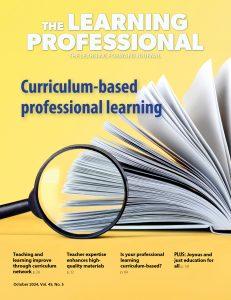When I heard about this year’s Learning Forward Annual Conference theme – transformation – I was inspired to plan a deep-dive preconference session on transforming schools for a population of students near and dear to my heart: multilingual learners (also known as English Language Learners or English Learners). With school populations growing more diverse, and opportunity gaps widening due to the pandemic, now is an important time to rethink the way we’ve been serving multilingual students. The work of reflecting, re-envisioning, and revising can’t be done by ESOL teachers alone. It must be a collaborative journey for educators at all levels and roles, which is why I invite each of you to join my preconference session on December 5th.
During the four-hour session, we will dive into the conditions for and steps to transforming schools so that multilingual students – and all students – can succeed. At the heart of this work is recognizing that the transformation comes from changing our own mindsets, practices, and structures, not trying to change students. Too often, multilingual learners are treated as a problem to be fixed when we should be seeing them as rich contributors to our communities. Engaging them in high-quality teaching and learning should not be a burden, but an opportunity to transform the whole school community for the better.
Together, we will explore the following three overarching strategies and their specific steps.
Strategy #1: Embrace change as an opportunity
In my work as a coach and professional learning specialist, I meet teachers and school leaders every day who share how their population of language learners is growing. With that, many challenges arise. But as the saying goes, with challenges come opportunities. When we are working with students who mirror the increasing diversity of our country and the world, I recommend first shifting our mindset from a reactive one to a positive and proactive one. A proactive, can-do mindset focuses on the questions “What can we learn?” and “What can we improve?”
Consider two different approaches to the same situation where a school has a rapidly-growing population of multilingual immigrant students. If a school leader says, “We are being inundated with newcomers! We are totally overwhelmed,” the implication is that immigrants are a stressor, an inconvenience, even an imposition. This mindset – which could be characterized as negative, at best – tends to lead to short-term, reactive strategies.
In contrast, a leader with a positive and proactive mindset might say, “At our school, we are working hard to welcome all the newcomer students and families, who are not just new to our community, but new to our country. It must be so challenging for them. We are trying to listen to their stories and learn what their hopes and dreams are so that we can better support them.”
How can we cultivate such positive and proactive mindsets? One strategy I encourage, which I will introduce during the preconference session, is using a sphere of influence approach. With this approach, educators mentally map out what they truly cannot influence, what they can influence, and even what they might be able to influence in time. When I did this exercise recently with a group of ESOL teachers, they realized that they could not directly address issues like scheduling and budget needs, but they could share scaffolds with other teachers, be ambassadors for students, and engage in professional learning about supporting multilingual learners. No matter your role, there’s a lot you can do to support multilingual students, and together, we’ll explore what some of those things are.
Strategy #2: Set a vision of access for all
Once we have the right mindset, how do we bring everyone in a school along so that multilingual learners can learn to their potential? We set a clear, descriptive vision of what we want for all students (and families). When supporting teams or conference participants in this process, I always start with a set of three questions:
- What does instruction where everyone belongs look like?
- What does instruction where everyone belongs sound like?
- What does instruction where everyone belongs feel like?
Through this visioning activity, we consider language and underlying assumptions. Teams of educators can clarify misconceptions around terminology and practices. For example, what do we really mean when we compare multilingual education to “mainstream” instruction, and what does the word “mainstream” communicate about our beliefs and perceptions of multilingual students? How might we change our language so that it is inclusive of all students and doesn’t imply that multilingual students are outside the norm?
When we establish inclusive language, we can then build a toolkit reflecting the shared vision of our collective responsibility to work with all learners. I encourage educators to apply this toolkit to their work across classrooms and contexts. We explore how language and literacy fit into every classroom and how that can help us meet standards for all students.
Once we are clear on our vision of instruction for all language learners (because all students are language learners – whether they are learning academic language with or without learning English for the first time), we can create learning environments that support everyone while layering in specific supports for those who need more. We can build systemic supports for both teachers and students around a vision that expects reading, writing, listening, and speaking in all classrooms and enables all students to have access to language-rich and literacy-rich experiences.
Strategy #3: Showcase growth through multiple data measures
When we think of data, we may only think of large-scale, summative assessment data, but formative measures matter, too. Data simply means information and if you can see it, hear it, even feel it, it’s measurable. Educators are collecting information constantly. In our preconference session, we will work on how to use it more effectively to inform our teaching and leadership.
We will consider how often we gather data, what kind of data we gather, and who values it, and we will begin to explore systems to use the data we already gather. For instance, what if we had teachers and students establish and reach for specific growth targets based on language proficiency levels, and then asked students to keep a portfolio of their growth? What if we celebrated this growth on a daily basis as we reached for those longer-term proficiency goals? During the preconference, I will share a student-friendly rubric and goal-setting form and we will brainstorm other strategies.
We will also delve into how coaches and supervisors can measure the growth of students and of teachers. For instance, if increased student-to-student discourse is part of our vision, we can provide professional learning, including coaching, around how to bring in academic discourse strategies and then, through inquiry cycles, observe and collect classroom data to help teachers improve.
Taking steps together
At the heart of this work is this question: “Are we integrating all students’ and families’ voices into our school’s vision and our daily practices?” To ask these questions constantly and be in a perpetual state of improvement is to start to center those who are historically the most marginalized. When we do that, we all learn and we all grow. I invite you to join me on this journey of transformation. It’s a journey that we won’t complete, but we can set out on the path together.
To register for Sarah Ottow’s preconference session, “Schoolwide Transformation for Multilingual Learner Success” (PC09), visit conference.lfstage.xyz.
More Learning Forward Blog posts by Sarah B. Ottow:
More about what English learners need now: https://lfstage.xyz/2021/04/29/what-english-learners-need-now/
More about what instructional leaders need now: https://lfstage.xyz/2021/02/19/how-instructional-leaders-can-thrive-during-the-pandemic/
More about a schoolwide approach to supporting ELs: https://lfstage.xyz/journal/april-2019-vol-40-no-2/take-a-schoolwide-approach-to-supporting-english-learners/






